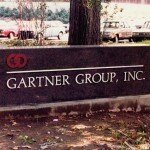 As mentioned, Gartner’s and Forrester’s (G&F) pricing policies in tandem suggest that they can live with each other peacefully, not bothered by competition. I can see the IT vendors accepting the increases because they’re hoping to indirectly encourage Advisory’s support of their product values (it would be interesting to know how their AR people are handling this). Is anyone nevertheless surprised at the large non-vendor enterprise clients accepting this lying down, if that’s what’s happening? My guess is that analyst services are so spread within each of the F100 and many smaller enterprises, that there’s absolutely no way for them to measure or even guess the values which they are receiving; perhaps I’ll soon learn more about this issue.
As mentioned, Gartner’s and Forrester’s (G&F) pricing policies in tandem suggest that they can live with each other peacefully, not bothered by competition. I can see the IT vendors accepting the increases because they’re hoping to indirectly encourage Advisory’s support of their product values (it would be interesting to know how their AR people are handling this). Is anyone nevertheless surprised at the large non-vendor enterprise clients accepting this lying down, if that’s what’s happening? My guess is that analyst services are so spread within each of the F100 and many smaller enterprises, that there’s absolutely no way for them to measure or even guess the values which they are receiving; perhaps I’ll soon learn more about this issue.
Hypothesis: nobody knows to what extent the underlying deliverables within the Advisory industry will increase in value or volume or both. As prices per unit of value are quite possibly rising, the market seems not to be pushing back, at least not yet except perhaps at the fringes. But can or will G&F’s vulnerability in fact grow as the years pass?
If they wished, both have volume and presumed cost controls to actually reduce price levels per unit of knowledge, and to therefore increase market demand as well as their revenue growth (depending upon the economy, of course). But as readers know better than me, there are definitely signs that many of the other Advisory players, large or small, are waking up. I’ve only recently begun to track the market more closely than in the last seven years, but am aware of the many senior analysts who have left Gartner or Forrester and others for various reasons, and I presume that most individual analysts have alternative strategies for success.
Likewise for the rest of this industry, new developing web functionality may allow further re-combinations and enhancements of data/information/knowledge/wisdom, to take full advantage of rapidly growing Internet capabilities. Therefore it is possible that in the Advisory space, some competitors with significant capital might not take G&F’s hypothetical vulnerability for granted, and succeed in growing rapidly.
A 100% guesstimate of how a truly innovative firm also rich in capability and capital might evolve? It could reach $150M revenue in 8 years (20% probability, 50% conviction, .2p,.6c). Not bad, but this could only happen to the extent that the new firm has an edge with new technology, content and analyst models, together with aggressive pricing and superior sales methods, all of which the current legacy firms might find difficult to duplicate. What would this do to the incumbents?
If I had to guess with no facts and therefore no analysis, G&F revenues in 8 years would possibly reach $2B and $600M revenue respectively, and thus continue to dominate!
Read Part I – Information vs Knowledge
Read Part III – Murray Gell-Mann







7 Comments